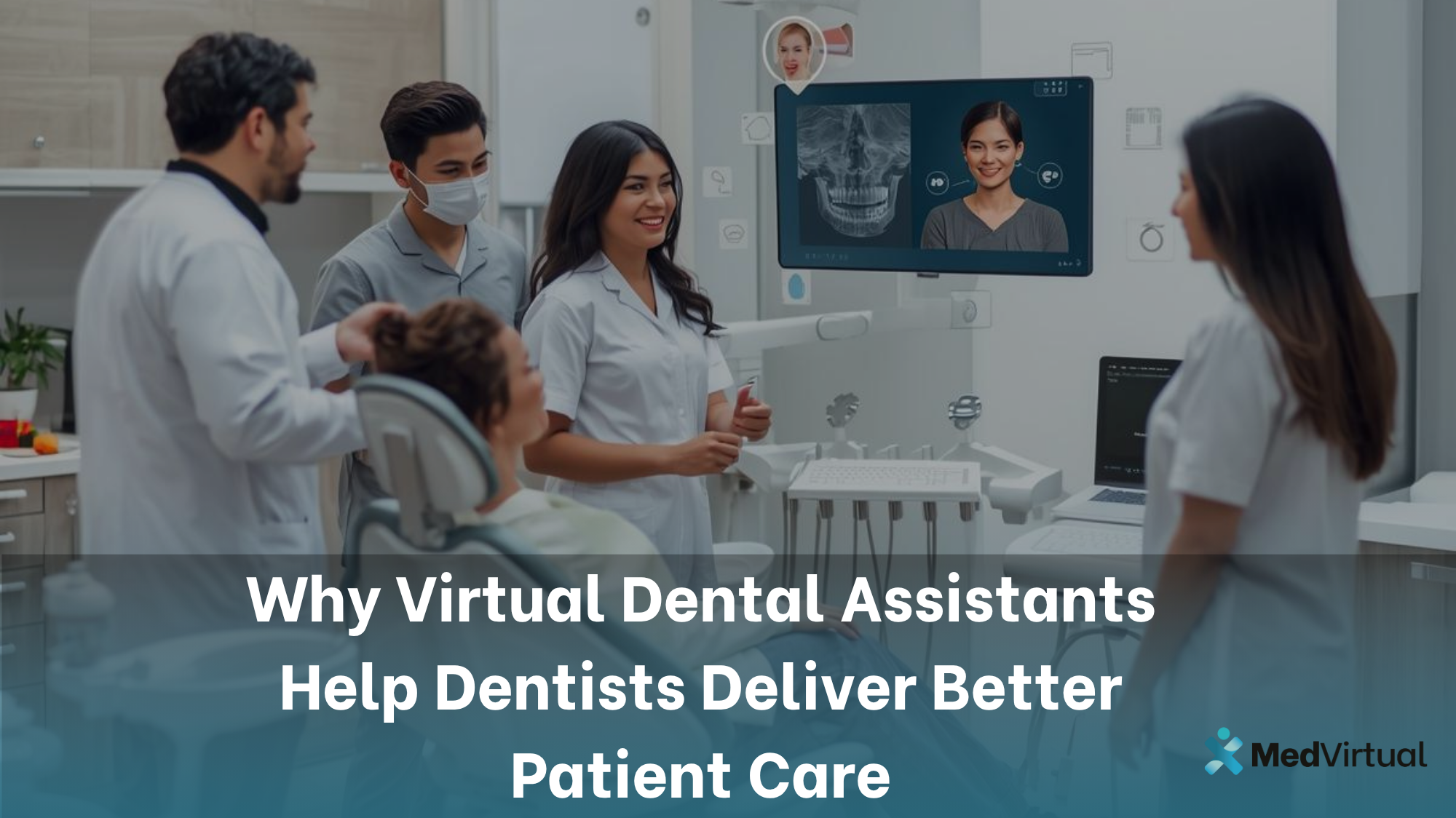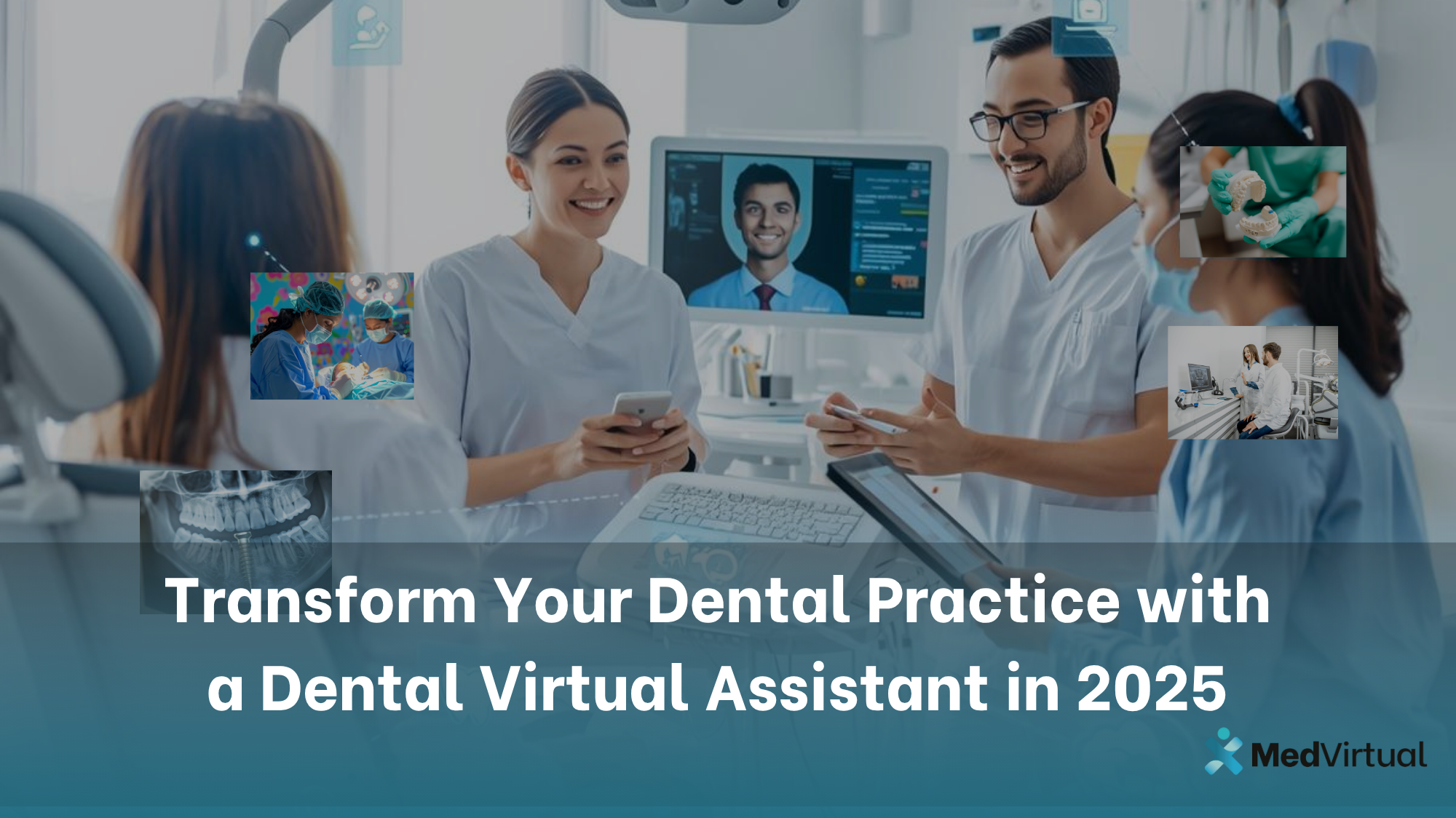Running a dental practice today means balancing exceptional patient care with the daily demands of scheduling, billing, and compliance. Studies show that administrative tasks can consume more than a third of a dental professional’s workday, limiting chairside time and slowing overall efficiency.
Virtual dental assistants (VDAs) bridge that gap. These trained remote professionals handle essential front-office and clinical coordination duties, from patient communication to insurance management, allowing dentists and hygienists to focus on patient outcomes instead of paperwork.
By integrating secure digital tools with human expertise, virtual assistants bring precision, responsiveness, and reliability to dental operations. They ensure that every part of your practice, front desk, billing, and patient follow-up, runs smoothly and compliantly.
What Is a Virtual Dental Assistant?
A virtual dental assistant is a trained remote specialist who supports dental practices with both administrative and patient-facing responsibilities. Unlike general virtual assistants, VDAs understand dental terminology, treatment workflows, and practice-management software such as Dentrix, Eaglesoft, or Open Dental.
Their expertise extends across appointment scheduling, insurance verification, treatment plan coordination, recall reminders, patient billing, and chart updates. Because they operate within secure, HIPAA-compliant systems, they can perform these tasks efficiently while maintaining strict patient privacy standards.
The result is a more organized, accurate, and patient-friendly dental practice, without the overhead of a full-time in-office staff member.
Reducing Administrative Burden and Chairside Burnout
Administrative overload is a leading cause of stress in dental practices. Confirming appointments, handling billing issues, and managing patient inquiries can easily overwhelm front-desk teams, especially in busy clinics.
Virtual dental assistants take on these time-consuming tasks. They manage recall schedules, track outstanding claims, and maintain up-to-date digital records. When repetitive administrative work is delegated, the clinical team gains valuable time to focus on diagnostics, procedures, and patient communication.
This shift improves efficiency, directly reduces burnout, and helps dental teams sustain higher productivity and morale throughout the week.
Enhancing Patient Communication and Retention
Every patient interaction shapes how your practice is perceived. Prompt responses, consistent reminders, and professional follow-ups build trust and keep patients returning for regular visits.
Virtual dental assistants specialize in managing these touchpoints. They ensure new patients receive clear instructions before their first visit, follow up after procedures to monitor satisfaction, and maintain regular recall communications for ongoing care.
Research in dental practice management shows that clinics maintaining consistent follow-ups experience up to 25–30% higher patient retention rates. By handling communication seamlessly, VDAs help strengthen patient loyalty and improve the lifetime value of every patient relationship.
Improving Billing Accuracy and Cash Flow
Dental billing and insurance coordination are often cited as the most complex parts of practice management. Delayed claim submissions or small coding errors can create costly backlogs.
Virtual dental assistants trained in dental billing standards help streamline this process. They ensure claims are submitted correctly, verify coverage before procedures, and follow up on outstanding payments. This proactive approach reduces denials and accelerates reimbursements, keeping your practice’s cash flow healthy and predictable.
Practices integrating virtual billing support often report measurable improvements in claim turnaround times and fewer administrative write-offs, directly impacting profitability.
Supporting Teledentistry and Digital Patient Care
As teledentistry expands, dental practices are discovering new ways to reach patients remotely for consultations, follow-ups, and treatment planning. Virtual dental assistants play a vital operational role in these systems.
They schedule virtual appointments, help patients navigate secure video platforms, manage consent forms, and document interactions in the dental record. Because they’re trained in compliance and digital workflow, they help ensure virtual consultations run as smoothly as in-office visits.
Incorporating VDAs into your teledentistry framework enhances patient accessibility while maintaining the same standards of confidentiality and care quality.
Maintaining Data Security and HIPAA Compliance
Patient data security remains paramount in dentistry. Virtual dental assistants operate within strict HIPAA and HITECH frameworks, using encrypted communication tools and verified access controls.
Their workflows typically include regular security training, activity monitoring, and controlled access to practice-management systems. Many dental organizations also align with SOC 2 Type II or ISO 27001 standards to reinforce data protection, ensuring that sensitive information stays secure from scheduling to billing.
By working with certified professionals who understand these compliance expectations, dental practices gain efficiency and peace of mind.
Choosing the Right Virtual Dental Assistant for Your Practice
Finding the right assistant begins with identifying your most excellent operational pain points. Some practices need help with scheduling and patient communication; others benefit most from billing or insurance expertise. The ideal VDA should have proven experience with dental systems, strong communication skills, and a track record of reliability.
Cultural fit matters too. The most effective assistants adapt to your practice’s tone, pace, and patient-care philosophy. Establishing clear expectations, structured onboarding, and regular feedback ensures long-term alignment and consistent performance.
Ultimately, a virtual assistant should feel like an extension of your in-office team, someone who upholds your standards and helps deliver the best possible patient experience.

Why Virtual Dental Assistants Are the Future of Dentistry
Virtual support isn’t a passing trend; it’s a reflection of how modern dentistry is evolving. As patient expectations rise and digital systems grow more complex, efficiency and flexibility have become competitive necessities.
Virtual dental assistants enable clinics to operate at that next level. They combine remote accessibility with specialized expertise, helping dental teams manage more patients, maintain compliance, and scale sustainably.
By embracing virtual assistance, dental practices aren’t just saving time, they’re building a smarter, more patient-focused model of care that’s ready for the future of dentistry.
Frequently Asked Questions
- Are remote dental assistants compliant with the Health Insurance Portability and Accountability Act (HIPAA)?
Yes, absolutely. Compliance with the Health Insurance Portability and Accountability Act is mandatory. Your remote dental assistants are specifically trained and operate within strict privacy and security frameworks, including HITECH protocols. Reputable providers will legally commit to these standards through a Business Associate Agreement signed with your practice.
- How do you guarantee the security of sensitive patient data?
Patient data security is ensured through multiple layers:
- Encrypted Connections: Assistants use secured connections, such as Virtual Private Networks, to access your dental software.
- Access Control: Access is limited strictly to the information and systems required for their tasks (like practice management software).
- Monitored Workflows: All activity is tracked, and assistants undergo regular security training to maintain the confidentiality of patient health information.
- Can a remote dental assistant use the specific software we already have?
Yes. Unlike general remote assistants, these specialists are hired for their proficiency with industry-leading dental practice management software, including Dentrix, Eaglesoft, Open Dental, and others. You will be matched with an assistant who is already familiar with your system to ensure a smooth transition.
- What tasks are remote dental assistants not able to perform?
Remote dental assistants handle all administrative, communication, and billing tasks that can be done digitally. They cannot perform any clinical duties, chairside assistance, or any task that requires a physical presence, such as taking X-rays, sterilizing instruments, or handing tools to the dentist.
- Will the remote assistant work during my practice's specific United States business hours?
Yes. We ensure that the assistant’s work schedule is aligned with your practice's local time zone and operating hours. This alignment is critical for real-time patient communication, scheduling, and seamless coordination with your on-site team.
- How does the cost of a remote dental assistant compare to a full-time in-office employee?
Hiring a remote dental assistant is significantly more cost-effective. You gain specialized help without absorbing the high overhead costs associated with a full-time hire, such as:
- Employee benefits and health insurance.
- Payroll taxes, social security contributions, and workers' compensation.
- The cost of office space, equipment, and utilities.
- How quickly can a practice begin working with a remote dental assistant?
Because these professionals are pre-vetted and already trained in dental-specific workflows, the entire process is much faster than traditional recruiting. Most practices can be matched with a suitable assistant and begin delegating tasks within a week of initiating the hiring process.




